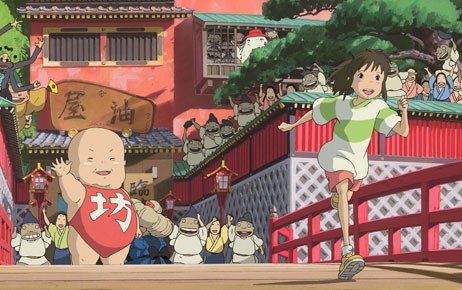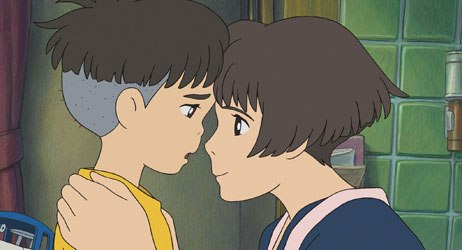With rare stops in California, Miyazaki talked about Ponyo and his legendary career in animation, and AWN captures the highlights in the first of two parts.
View trailers and clips from Hayao Miyazaki's latest, Ponyo!
It's not often that the great Hayao Miyazaki comes to town in support of his films. Although he came to L.A. when the English-language version of Spirited Away was released, he refused to attend the Academy Awards to collect his Oscar in protest of the Iraq war. But John Lasseter, Kathleen Kennedy, Frank Marshall and Disney as a whole are pulling out all the stops to ensure the greatest possible box office success for the English-language version of Ponyo (opening today). They're launching the Hans Christian Andersen-inspired fable on 927 screens: the largest rollout ever for Miyazaki in this country.
Not surprisingly, the reviews have been glowing. Ponyo arguably skews younger than previous Miyazaki films and has a simpler design, but it succeeds in enchanting young and old alike. It is the tale of a magical goldfish (voiced by Noah Cyrus) that wishes to break free from her overbearing, wizard of a father (voiced by Liam Neeson), and become human to maintain a friendship with a five-year-old boy (Frankie Jonas) in a nearby seaside village. Although he has loving parents (Tina Fey and Matt Damon) his father is rarely home so they have their own issues to work out.
Last month Miyazaki made his first trip to Comic-Con in San Diego before holding a press conference with Lasseter in Beverly Hills and then getting feted later that evening at the Academy of Motion Picture Arts and Sciences: chatting for a couple of hours with the chief creative officer of Walt Disney and Pixar Animation Studios.
The following is an edited transcript of the press conference; the second part will be a recap of "The Marc Davis Celebration of Animation: Hayao Miyazaki."
AWN: How do come up with your worlds?
Hayao Miyazaki: I do all my work on storyboard, so as I draw my storyboard, the world gets more and more complex. And as a result, my north, south, east, west sense of direction kind of shift and go off base. But it seems like my staff as well as the audience don't quite realize that this is happening. Don't tell them about it.
AWN: How important is it to get elements [about preserving the environment] into your films?
HM: The most important thing is, I think, that even within such an environment, children grow up, they learn to love and they enjoy living in that environment.
AWN: What was the original inspiration for Ponyo?
HM: I think John Lasseter knows as well, but it's really hard to explain what becomes the motivation or the instigation to do a film. I feel like I'm searching in my subconscious with a fishing net and I happened upon catching a goldfish in that net and that was the inspiration for starting to make this movie.
AWN: What have been some of the influences throughout your career?
HM: There are many, many people so I can't give all their names. And I forget their names. So I can't really tell you.
AWN: John, how difficult was it to getting the script, getting the dialogue to coordinate with the voice movements already done and then getting the [appropriate] voice talent?
John Lasseter: One of the biggest challenges in taking and creating the English language versions of Miyazaki sans' films… is that I don't want the English versions to change anything in [his] story. The first thing we do is get a direct translation. Even though the sentences will be hard to understand, I just want to know exactly what's being said. And then I work with Steve Alpert at Studio Ghibli and we'll rearrange the words to fit into sentences. And that's our starting place. And, in this case, we worked with Melissa Mathison, the brilliant screenwriter, and Kathy and Frank, the co-executive producers with me, and we'll sit down to discuss every step of the way what we want to do with this. And the goal is to make the [language] for American audiences to be very natural -- you don't think of this as being a dubbed Japanese film. We want everyone to just swept away with this story. However, there are some things that Japanese audiences will understand visually that American audiences won't. And in those cases, what I strive to do is make sure that the American audience will be at the exact same level of understanding at any one time in the movie that a Japanese audience would be. And sometimes that's a bit of a challenge. An obvious example of that was on Spirited Away when the main character was exploring the village and looks at this building. All Japanese audiences would know right away that it's a bath house. But no one in this country would know… so we just added a little line.
Then what we do in casting of the voices we really aimed high on this one and I really credit Kathy and Frank for really getting the amazing cast that we have. And what's nice is that when everybody found out that it was a Miyazaki film they said, "Yes, I want to do this." And then working with them there were challenges. One of the things to understand is that in Japan, especially with Miyazaki, he always records the original dialogue after he's finished the animation, which is different from what we do in this country -- we always record the dialogue before we do the animation. And so the lip synch is somewhat on the rough side anyway, so it helps us kind of try to fit the words in there. But we try very hard in working with the actors to get the lines of dialogue to fit with the right mouth movements…
AWN: After using computer technology on a couple of films, Ponyo marks your return to completely hand-drawn animation. Was there something specific to Ponyo that inspired that? And what would you say are the differences between computer-generated and hand-drawn animation?
HM: Actually, at Studio Ghibli we dissolved the computer graphics section before we started production on Ponyo. So we had decided at that point to stick with hand-drawn animation. And then the difference between computer-generated and hand-drawn -- just as John Lasseter and I are different -- I think I can leave the computer-generated animation to him and I can stick to the hand-drawn animation.
AWN: You've mentioned before that Ponyo started out as a frog before becoming a gold fish. Why the change?
HM: There was a children's book that gave me a hint at the beginning and I was thinking of using that as the original story to work from. And that was the frog in there. But as I worked on the story, it became something completely different… so I didn't pursue that direction. I have told the author of that children's book that that was the hint for this film, though. Sometimes, I test myself, wondering, if I get a death sentence if I don't make this movie, would I still make this movie. And that's where the frog came into play.
AWN: What is your impression of stereoscopic 3-D? Would you like to make a movie in 3-D? And there are movies like Toy Story that are being converted to the 3-D format. Would you ever consider converting one of your prior films?
HM: I don't think we would make a 3-D film -- at least while my producer, Toshio Suzuki, and I, are alive.
AWN: Since this is a variation on The Little Mermaid, was the Disney version any influence at all?
HM: I watched the video of The Little Mermaid many years ago when I was first given it, but I haven't watched it recently. And, on purpose, I didn't watch it while making this film.
AWN: The bond between parents and children is very strong in Ponyo. What do you want parents and children to get out of these relationships?
HM: I think what is most important is that parents and children see each other as being very valuable and very precious to each other, and if they can get that out of the movie that's fine.
Bill Desowitz is senior editor of AWN and VFXWorld.










